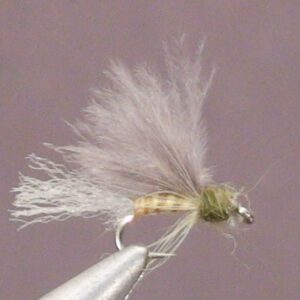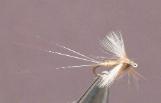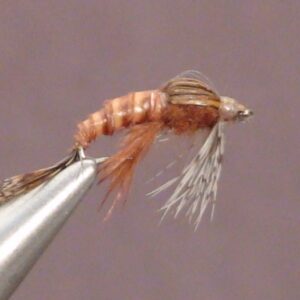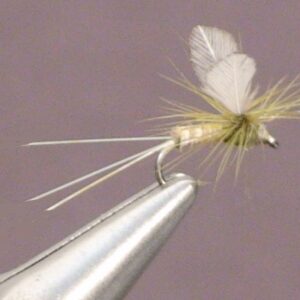Hook Size: 16/18
The Pale Morning Dun mayfly emerger is a trout fly that imitates the nymph changing to a dun. It looks a little more like the nymph than the dun. It imitates the nymph accenting from the bottom to the surface of the water. The CDC wing should float flush with the surface skim.
PMDs, or Pale Morning Duns emerge, as their name implies, in the morning from about 9
am to 11am as a general rule. Like many other mayfly hatches the activity usually last
only a short time, an hour or so, although it may go much longer on during cloudy,
overcast days. These mayflies seem to prefer adverse weather to hatch because the
hatches continue for much longer periods of time under these low light conditions.
The PMD nymphs swim to just beneath the surface of the water and shed their nymphal
casing. It’s during this time that the nymphs are suspended that the trout have the best
opportunity to feed on the emerging duns.
Early season hatches of Pale Morning Duns commonly have a large proportion of
cripples and trout are well aware of that it seems, feeding on them with ease. Many
anglers prefer using cripple imitations. We disagree because we don’t think imitations of
the cripples outperform better imitations of the emergers at any time.
Presentation:
Our Perfect Fly emerger imitations fished in the surface skim of the water imitating the
emergers are usually very effective during a hatch. In fact, they are actually more
effective than the dun imitations in most cases. The emergers are more difficult to fish
and some anglers have a difficult time concentrating on flies they have a difficult time
seeing.
You can begin by dead drifting the Perfect Fly Pale Morning Dun emerger. It’s a CDC
winged emerger that floats flush with the surface skim. Many anglers prefer to use the
Perfect Fly Pale Morning Dun emerger with the Trailing Shuck. It is easier to see and
therefore a little easier to fish but both of these imitations of the Pale Morning Dun
emerging nymphs are very effective.
Normally, PMD nymphs migrate from the moderate sections of water to hatch in calmer,
slower moving water that is near their normal habitat. A long leader and tippet of 6x or
even 7x will get far more takes from the trout than something shorter and heavier. 5X
tippets will work in many cases but in some cases the lighter tippets are better.
Smooth flowing water can require a down stream or cross-stream presentation that is
made to an individual rising fish. In pocket water, you are much better off fishing the calm
areas of water within the stream using an up or up and across presentation.
You may not want to stick with the emerger fly pattern very long after the hatch
begins. They are very effective flies but you can catch plenty of trout on dun patterns or
the dry fly which most anglers prefer.
Copyright James Marsh 2013




